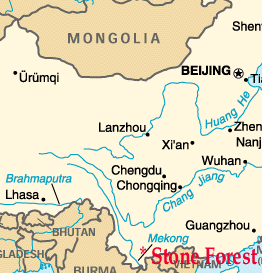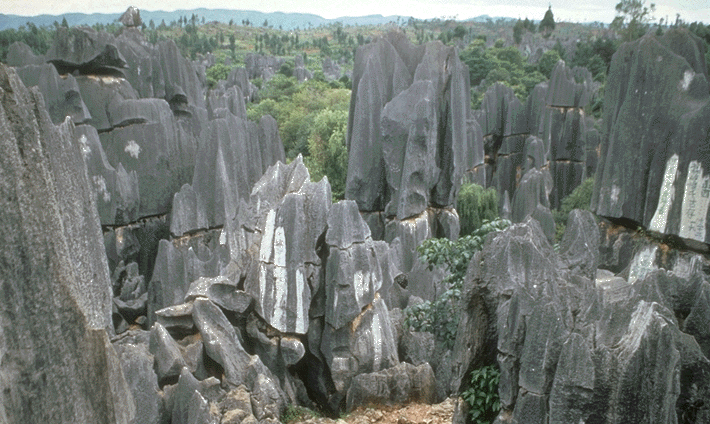 The Stone Forest is situated in the Lunan Yu Autonomous County, 126 kilometers southeast of Kunming. A region of typical karst formation, the Stone Forest covers an area of more than three hundred square kilometers.
The Stone Forest is situated in the Lunan Yu Autonomous County, 126 kilometers southeast of Kunming. A region of typical karst formation, the Stone Forest covers an area of more than three hundred square kilometers. Geological research (Geng Hong, Cheng Shuyun, and Luo Suxiang, A Geological Excursion Guidebook to the Karst Landscape in the Lunang Region, Yunnan Province, 1987) has shown that what is now the Stone Forest was some 270 million years a shallow sea. Extensive deposits of sandstone overlain by limestone accumulated in this basin during the Permian period of geologic time. Uplift of this region occurred subsequent to deposition and exposure to wind and running water shaped these limestone ridges. These formations extend as far as the eye can see, looking like a vast forest of stone, hence the name "the Stone Forest".
"Kunming, which is situated in central Yunnan Province and north of the Dianchi Basin, is skirted on three sides by mountains, with one side opening onto Dianchi Lake. The Stone Forest is within some hundred miles of the northern borders of Thailand, Nyanmar (Burma) and Vietnam.
Kunming is nicknamed "City of Spring" due to the fact that it is covered all year round with the rich verdure of trees and plants. Endowed with a pleasant climate, the city's 15,000 square kilometres of land is adorned with more than 400 kinds of flowers" (Tour Kunming.)
 One of the underlying principles of geology is the so-called Principle of Uniformitarianism which is often paraphrased as the present is the key to the past. If you want to study a ancient delta you could begin with a study of a modern one. If you are interested in variations in style of volcanic eruptions you might wish to compare the activity of the modern Hawaiian Islands with the rocks and structures near the Craters of the Moon in Idaho. If you want to study the effects of underground water on limestone with the potential for the development of caves and sinkholes, you might want to visit the Stone Forest south of Kunming.
One of the underlying principles of geology is the so-called Principle of Uniformitarianism which is often paraphrased as the present is the key to the past. If you want to study a ancient delta you could begin with a study of a modern one. If you are interested in variations in style of volcanic eruptions you might wish to compare the activity of the modern Hawaiian Islands with the rocks and structures near the Craters of the Moon in Idaho. If you want to study the effects of underground water on limestone with the potential for the development of caves and sinkholes, you might want to visit the Stone Forest south of Kunming.Is a Virtual Field Trips to the Stone Forest as good as going there in person? Not really. However, not everyone may have the opportunity, time or funding to visit this fascinating corner of the world. One hopes that as a result of a field trip (virtual or in person) that the observer has the opportunity to not only see but to think. To make use of what knowledge they bring on a trip to gain a better understanding of the geologic history of the area should be a common goal of all participants.
The developers of the Virtual Field Course argue as follows. "We do not seek to replace field work, rather to enhance and extend it." The developers of this Internet document embrace their statement.
Like Moby Dick, a virtual field trip can be dealt with on several levels. The reader could simply be a voyeur, looking at the pretty images, making appropriate oh's and ah's and then clicking off to the next site on the web. Or, the reader could be engaged and challenged to apply his/her knowledge to gain an understanding of principles and processes. If knowledge is lacking, the reader should be able to review or learn the basic principles before continuing the trip.
I had the opportunity to visit Kunming, People's Republic of China, in June of 1999 with my new friend Peng "Jack" Zhang from Kunming University of Science and Technology.
The remainder of this document is organized as depicted in the Table of Contents that follows. Suggestions will be made as you go through the material but, unless you are taking a formal course and your instructor insists, what you do is up to you. Only you will know!
